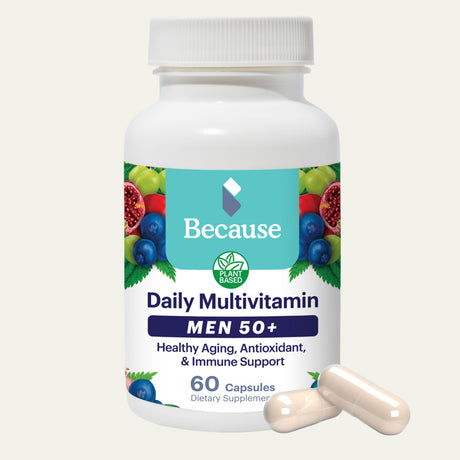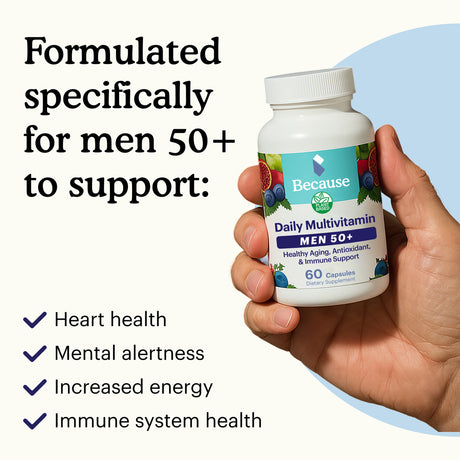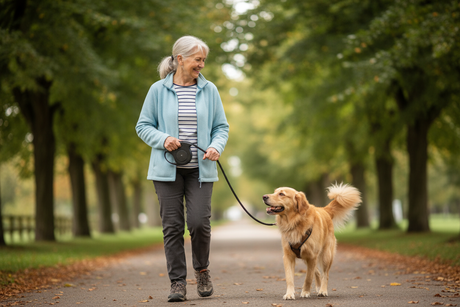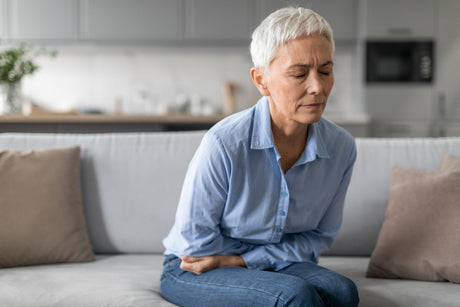Our bodies are constantly changing and growing, but it’s normal to experience changes in height and posture with age. There are exercises for seniors to prevent and delay changes and relieve back pain. In this post, we'll explore the causes of poor posture and introduce ten exercises to improve it.
Why Is Good Posture So Important as We Age?
Bad posture can lead to many problems, including chronic pain. Slouching puts extra strain on the spine and can lead to inflammation over time. When tissues around the spine become inflamed, people may experience aching pain in their shoulders, neck, and lower back.
Having poor posture isn’t just a strain on our back muscles; it can also increase the risk of falling and injury, interfering with mobility. Improve posture helps you look your best, which increases your self-confidence and self-esteem. That’s why exercises for posture for seniors are so important.
Easy Posture Exercises for Seniors
The good news about posture is that it's possible to improve it with regular exercise. Here are five of the best ones to try.
 1. Chin Tuck Exercise
1. Chin Tuck Exercise
The chin tuck exercise focuses on upper back posture and targets the bones in your neck at the end of the cervical spine. Many people with poor posture jut their necks forward, which can cause forward head posture and shoulder pain. This exercise focuses on training the neck muscles to relax from this jutted-forward position and sit in a neutral position instead.
It can be done sitting or standing up straight. Move your chin toward your spine as though you are “tucking” it into your neck. Next, move your chin back to the position it was in, “jutting” it away from your body. Note that your head should not move up or down but stay relatively straight during these movements.
You can repeat this exercise for a few minutes each day.
2. Wall Tilt Exercise
This exercise promotes lower back posture. It focuses on the pelvic and gluteal muscles to target the lower back and build strength. A bonus of this exercise—it’s a great way to relieve lower back pain!
To perform this exercise, stand straight against the wall and position your hand flat against your lower back. Keep the back of your head and your shoulders touching the wall throughout the exercise. Next, tighten the muscles in your stomach and tuck your pelvis under. Your back muscles should flatten, and your lower back should straighten out. You’ll also feel pressure on your hand if you’re doing it right!
3. Wall Arm Circles
Another exercise that improves posture is wall arm circles. These can be done similarly to the wall tilt exercise. Stand flat against a wall and take a few small steps, so your feet are about six inches away from the wall. Next, lean your body backward so your head touches the wall. Tuck your pelvis in so your lower back touches the wall.
You can also incorporate your arms if you want to build on this exercise. Slowly put your arms flat against the wall and lift them over your head. Continue touching the wall while moving. Lower your arms back down and repeat.
You can perform this exercise regularly for a few minutes per day.
4. Scapular Retractions
This exercise targets your shoulder muscles. To perform a scapular retraction, you’ll need a resistance band. Sit or stand tall and loop the band around a solid object like a door knob, sturdy table leg, or bedpost. Make sure the band is secure, and you can pull on it without the structure holding it moving out of place.
Firmly hold the resistance band with both hands. If you are sitting, stand straight up and walk backward until your arms are completely extended, the resistance band is stretched, and there is tension on the band. Then, pull both shoulders back toward each other. Try to picture your shoulder blades touching during this exercise.
After performing a few of these movements, you’ll notice how your posture is already more natural and improved!
5. Bird Dogs

This stretching exercise is one that you do on the floor. Position yourself on your hands and knees about shoulder-width apart. For extra comfort, use a yoga mat or a softer surface so you don’t hurt your knees.
Keep your head facing the ground in a neutral position and tighten your stomach muscles so your back straightens. Lift one leg behind you, so it’s level with your back. Lift the opposite arms in front of you, so it’s level with your body. Hold this position for five to ten seconds, keeping your back straight and your arm and leg stable. Alternate arms and legs and repeat for a few sets.
You can also break this exercise up into pieces. You can extend your right leg straight, holding it there and lowering it down, and then lift your arm and do the same exercise.
6. Wall Posture Training
Although wall training is one of the best posture exercises available for seniors, it is incredibly easy, making it an excellent option for those who are just beginning to exercise and have yet to develop sound muscle tone.
To do it, stand with your back against a wall. Concentrate on pressing your entire spine against the wall. Start by lengthening your neck and then mentally travel down your spine, putting each part of your back in the proper position. Finally, rest the back of your head against the wall, keeping your spine in a neutral position without arching.
Hold for at least 30 seconds. If you feel comfortable, stay there longer. Over time, you can develop muscle memory that may make it easier to maintain good posture throughout your lower and upper body.
7. Shoulder Blade Squeezes
Shoulder blade squeezes are an excellent exercise for learning how it feels to have your spine in a neutral position that isn't arched or rounded. It also helps you keep your shoulders below your ears, reducing the hunching action that can contribute to bad posture.
To do this exercise, stand with your arms hanging at your sides. Relax your spine and pelvis. Then, bend your elbows and lift your arms so they are parallel to the floor. Slowly move your elbows back, imagining that you're trying to squeeze a pencil between your shoulder blades. Continue back as far as you can and hold for a few seconds. Then, bring your arms back to the starting position. Repeat ten times.
8. Shoulder Circles
Regularly performing shoulder circles can improve flexibility through your shoulders and rib cage while training you to hold your spine in a straight neutral position. You'll need to sit in a chair with your back straight for this exercise.
Once you're in a comfortable position with your feet on the floor, raise your shoulders as if they’re trying to touch your ears. Then, roll your shoulders back as you lower them back down. Repeat the exercise 10 times, ensuring you return to the starting position between each rep.
9. Chest Stretches
A chest stretch can help tone the muscles needed to retain proper upright posture while also easing tension to leave you feeling great. Begin by settling on a sturdy chair with your spine long and your shoulders back and down. Put both feet on the floor and look directly in front of you.
Lift your arms so they're parallel to the floor. Don't worry if you can't hold your arms at a 90° angle. Just raise them as high as you can. Then, pull your arms back as far as you can as if you were rowing a boat.
Hold the pose for as long as you can, and then slowly release. At first, you may only be able to maintain it for 30 seconds, but over time, you should be able to stay in the pose longer. Continue to practice until you can stay in the chest stretch for three minutes.
10. Walking

Maintaining better posture through your upper and low back can come through regular brisk walking. However, you'll need to focus on keeping your spine long, and your head lifted while you move to get the most benefits. Walking is also one of the best ways to get cardiovascular exercise for seniors.
Not only can cardio reduce your risk of health conditions like heart disease, heart attack, and stroke, but it can also aid in weight management. Losing weight may help improve your posture by shifting your center of gravity and placing less strain on your spine.
Risk Factors of Poor Posture in Older Adults
The system responsible for posture is called the musculoskeletal system. This system contains the bones that make up the spine and the muscles that help keep your spine strong and tall.
Aging is the most common cause of poor posture. Our body's aging often results in the involuntary loss of muscle mass. Once we reach the age of 30, muscle mass can decrease up to 8% per decade. Once we reach 60, this percentage can double.
There are a variety of factors that influence this loss of muscle mass. Here are some of the most common factors.
Decline in Physical Activity
Often, muscle loss is a result of inactivity. A decline in activity isn’t always voluntary. Bedrest, injury, or illness can result in a decrease in your physical activity. Lack of physical activity is one of the most significant contributing factors besides age that affects muscle loss, so it’s crucial to ensure your body gets the exercise it needs to build and maintain muscle.
Inadequate Nutrition
An unbalanced diet is another leading cause of losing muscle. If you are not consuming the calories, nutrients, vitamins, minerals, and proteins your body needs, it won’t be able to synthesize muscle. As we age, our tastes, appetites, and eating patterns change. These changes result in inadequate nutrition, which leads to muscle loss and poor posture.
A multivitamin made for older adults can help you get the nutrients your body needs while providing other essential vitamins and minerals to promote your overall health.
Hormonal Changes
Hormones are chemical messengers that travel through the blood and send signals to every organ in our body to perform different functions. They are vital for many bodily processes, including development, growth, metabolism, brain function, and the production of essential substances.
However, as we age, our hormones also change. Some hormone levels in the blood increase, while others decrease. Our body’s target receptors may become more or less sensitive to certain hormones, which can affect the organs and how well they perform their functions.
The specific hormones that increase muscle growth and metabolism are the growth hormone, insulin growth factor, and androgens. These hormones build up muscle mass rather than break it down. Some hormones that decrease and potentially break down muscle mass are called glucocorticoids.
When we age, our bodies may make fewer hormones that build up muscle and more hormones that break it down. Not only does this shift contribute to poor posture, but it also can weaken the pelvic floor muscles and contribute to incontinence. This effect makes it especially important to invest in exercise.
Tips to Safely Perform Postural Exercises for Seniors
To ensure safety when completing posture exercises, follow these tips:
- Talk to your doctor about whether the example exercises above are right for you.
- Modify exercises as needed to avoid strain.
- Start slowly, doing a limited number of exercises once or twice weekly. Then, gradually increase over time.
- Wear loose-fitting or stretchy clothing that won't restrict your movements.
- Don't exercise barefoot. Wear sneakers with good treads to give you solid traction.
- Have a caregiver nearby the first few times you exercise.
- Discontinue any exercise if you experience extreme discomfort. A dull ache is normal but a sharp or stabbing pain may not be.
What Are the Benefits of Posture Exercises Over Time?

Over time, postural exercises for seniors can provide a multitude of benefits, including:
- Higher energy levels
- Better mood
- Increase in self-esteem and confidence
- Easier breathing
- Less risk of falls and injuries
- Reductions in back pain, neck pain, shoulder pain, and headaches
- Improved mobility that makes it easier to complete daily activities
Other Ways Seniors Can Support Good Posture
Can you correct your posture in your senior years? The answer is: yes. Older adults can make a difference in their upper and lower back posture by adopting good habits, lifestyle changes, and regular exercise. While it may not be possible to reach the point where proper posture becomes second nature, you can significantly improve your body alignment when moving, standing, and sitting.
In addition to starting a posture-focused exercise program, following these tips can help:
Eat a Balanced Diet
By giving your body the nutrients it needs to synthesize muscle and stay strong, you can help improve your posture and keep your musculoskeletal system healthy.
Many older adults experience changes in taste and appetite due to medication. If you’ve noticed a decrease in your caloric intake, talk to your doctor about the possible side effects of the medication you’re on.
If you’re not getting enough food, you likely lack nutrients. Talk to your doctor about whether a probiotic supplement or omega-3 supplement is right for you! These can help you get some of the nutrients you may miss in your diet.
Take Calcium and Vitamin D Supplements
Vitamin D helps with the production and regulation of calcium in our bodies. Calcium is responsible for the building of the bone structure in our bodies. Calcium and vitamin D supplements can support your body’s production of calcium and strengthen your bones. These supplements may also help to reduce the risk of osteoporosis — a condition that causes the bones to become brittle and weak.
Pay Attention to Your Posture During the Day
While you’re at the dinner table, watching television, using a computer, or walking at the grocery store, pay attention to your posture. Relax your shoulders and tighten your abdominal muscles if you notice yourself slumping. The more times that you do a mental posture check during the day, the better!
Exercise Regularly and Strengthen Your Core
Regular exercise is essential for your overall health as well as your posture. The U.S. Centers for Disease Control and Prevention (CDC) suggests that seniors do strength training workouts at least times per week. Strengthening your lower and upper back muscles can reduce pain and help you stand straighter. Core exercises that tone the abdominal muscles can also increase the support given to your vertebrae, further improving your posture.
Sources:
PubMed Central (PMC). (2010). Sarcopenia: The Mystery of Muscle Loss. https://www.ncbi.nlm.nih.gov/pmc/articles/PMC2804956/#:~:text=One%20of%20the%20most%20striking,60%20%5B4%2C5%5D.PubMed. (2015). Hormones as Important Regulators of Muscle Mass and Strength in Aging. https://www.ncbi.nlm.nih.gov/pubmed/26073423
PubMed. (2018). Hormonal Regulation of Muscle Hypertrophy in Aging. https://pubmed.ncbi.nlm.nih.gov/30390253/#:~:text=Hormones%20such%20as%20growth%20hormone,important%20regulators%20of%20muscle%20mass.
University of St. Augustine for Health Sciences. (n.d.). How to Improve Posture: A Comprehensive Guide. https://www.usa.edu/blog/how-to-improve-posture/
Centers for Disease Control and Prevention. (n.d.). Older Adults. Physical Activity Basics. https://www.cdc.gov/physicalactivity/basics/older_adults/index.htm














